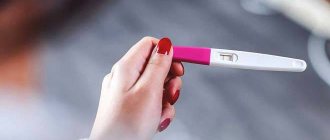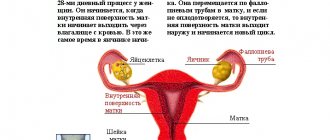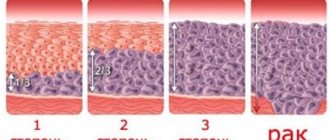There is probably not a single woman, and even men, who do not know what the abbreviation for the specific female condition PMS stands for - premenstrual syndrome. We often use these biting three letters when we want to tease someone aggressive or irritated, who is not in control of their emotions: “You probably have PMS?” But you shouldn’t use this trick, because PMS is a really unpleasant condition.
There is also a male version of deciphering these letters - the Period of Male Suffering. Today we’ll talk about how to experience PMS painlessly for both women and the men around them.
Causes of PMS in women
The theory of the causes of PMS, based on changes in a woman’s hormonal levels, is still considered the most substantiated from a medical point of view. According to her, a premenstrual symptom occurs due to an imbalance of estrogen and progesterone in a woman’s body. In large quantities, these hormones retain fluid in the body, which causes the appearance of edema, exacerbation of problems with the heart and blood vessels, swelling of the mammary glands, and bloating. And estrogen “acts out” on a woman’s psycho-emotional state, making her irritable and aggressive.
The impetus for the development of prolonged and intense PMS can be the following phenomena in a woman’s life:
- abortion;
- incorrectly selected hormonal contraception;
- infectious diseases;
- pathologies were detected during pregnancy or childbirth.
All this leads to the fact that in the second half of the cycle the level of natural progesterone produced by the ovaries decreases.
Risk factors for developing PMS1
If modern medicine already understands what PMS is in women, the reasons for its occurrence still have not been able to be established even as a result of numerous studies. There are many theories of its occurrence, but the most complete and closest to reality can be called the hormonal theory. She explains PMS symptoms by fluctuations in the level of sex hormones in the second phase of the menstrual cycle. In order for the female body to function normally, a balance of female sex hormones is necessary: progesterone (“pregnancy hormone”, which helps to bear the fetus), estrogens (“femininity hormones”, responsible for the normal functioning of the female body) and androgens (“male hormones”, which are also produced in female body). In the second phase of the cycle, a woman’s hormonal background changes and, according to this theory, the body as a whole and certain parts of the brain do not react quite adequately to this. This is exactly how PMS appears.
According to doctors, the most likely factors influencing the development of premenstrual syndrome are: 5
● Decreased serotonin levels (serotonin is a compound that controls the transmission of impulses from the brain to the body. Serotonin levels affect emotional states such as a sense of well-being, self-esteem, fear, etc.) - is a possible cause of mental symptoms of PMS (depression, apathy, tearfulness, melancholy, etc.);
● Lack of magnesium – can cause headaches, rapid heartbeat, dizziness;
● Vitamin B6 deficiency – leads to fatigue, swelling, mood swings and increased sensitivity of the mammary glands;
● Genetic factor – manifestations of PMS can be inherited;
● Overweight – women with a body mass index over 30 are at particular risk (to calculate your body mass index, divide your weight in kilograms by your height in meters squared);
● Smoking – doubles the chances of PMS in women;
● Consequences of abortion and complicated childbirth, gynecological pathologies, stress.
You should consult a doctor about premenstrual syndrome if its manifestations are severe and significantly reduce the quality of life, including affecting performance. After the examination, the doctor will give all the necessary recommendations to alleviate this condition and prescribe drug therapy to the patient, if there is a need for it.
Symptoms of PMS in women: list
So, we all know that PMS is an extremely unpleasant condition; many women have a hard time with it, both physically and psychologically. Let's look at the symptoms of PMS in different aspects:
Physical signs:
- General deterioration in health - dizziness, heaviness or aches throughout the body, difficulty breathing, which may periodically become confused, rapid heartbeat, periodic increase or decrease in blood pressure.
- Pain in the lower abdomen is nagging, aching, which either subside or reappears. The abdomen swells, constipation may appear, and the frequency of urination, on the contrary, may increase.
- Pain in the mammary glands, their fullness, excessive sensitivity of the nipples.
- Possible headaches, nausea, chills or increased body temperature, discomfort in the joints and lower back.
Psychological (emotional) signs:
- Mood changes - irritability, apathy, tearfulness, memory loss, indifference to everything, a state bordering on depression may be present. A woman in this state can easily be enraged and made nervous.
- Sleep disorder – a woman may feel drowsy more often than usual, or, conversely, suffer from insomnia at night.
- There is an exacerbation of anxiety attacks, panic attacks or causeless panic may occur.
Individual (subjective) signs. Many representatives of the fairer sex during PMS complain of:
- weight gain,
- swelling,
- increase in body volume,
- exacerbation of psychosomatic reactions (annoyed by excessively loud sound, too bright light, etc.);
- increased appetite, change or exacerbation of taste preferences;
- a decrease or vice versa – an increase in libido, unexplained surges in sexual activity.
Indeed, it is difficult to call a girl with such a “set” of symptoms a happy person. Fortunately, not all women experience the entire list of PMS symptoms and, of course, the named symptoms do not make themselves felt immediately and simultaneously. Let us highlight the forms of PMS severity, based on which we will further look for ways to combat premenstrual syndrome.
PMS4 classification
Depending on whether they belong to a particular body system, there are several clinical forms of premenstrual syndrome in women:
1. Neuropsychic (brain) form - includes disorders of the nervous system and emotional sphere. Patients complain of touchiness, tearfulness, irritability, increased sensitivity to sounds and smells, sleep problems, and fatigue. Constipation and bloating may occur due to the accumulation of excess gases in the intestines. Adult women experience depression, and adolescents experience attacks of aggression.
2. Edema form - occurs against the background of a temporary change in kidney function, when excess fluid accumulates in the tissues of the body, including the mammary glands. Patients note weight gain, swelling in the face, hands and legs, as well as discomfort in the chest.
3. Crisis (suddenly worsening) form - a complex set of disorders of the cardiovascular and digestive systems, as well as kidney function. Patients report pain in the area behind the sternum, rapid heartbeat, high blood pressure, and panic attacks. Often this form of PMS occurs in women during premenopause (the end of the period of childbearing ability).
4. Cephalgic form (a form with a predominance of neurological and vascular symptoms) - characterized by headaches, dizziness with nausea and vomiting, migraines.
5. Atypical form - an atypical combination of symptoms, for example, suffocation, vomiting, fever and migraine.
6. Mixed form - a simultaneous combination of several forms of PMS. Most often we are talking about emotional and edematous forms.
There are also several stages of development of premenstrual syndrome:4
● Compensated stage – PMS is mildly expressed, does not progress over the years, all symptoms disappear immediately after the start of menstruation.
● Subcompensated stage – symptoms are so pronounced that they limit a woman’s ability to work and continue to worsen over the years.
● Decompensated stage – an extreme degree of severity of PMS, the symptoms of which disappear only a few days after the end of menstruation.
Based on the number of symptoms that form premenstrual syndrome in women, a distinction is made between mild and severe severity of the disease. If three or four symptoms are present with a predominance of one of them, we are talking about a mild form of PMS. If from 5 to 12 symptoms constantly appear, of which several are the most pronounced, a severe form of the disease is diagnosed. Due to the variety of symptoms characteristic of a number of pathologies of the neurological, hormonal and gynecological spectrum, the main and almost only diagnostic criterion in the case of PMS is a clear connection between the existing symptoms and the approaching menstruation, as well as the cyclical repetition. In addition, it is necessary to take into account the characteristics of a woman’s emotional makeup.
Forms of PMS in women
A mild form is when a woman experiences 3-4 of the above symptoms of PMS and they do not have a serious impact on her well-being and lifestyle. This stage does not require treatment; it is enough to simply treat the girl with care and understanding during this period.
Medium form – there are more signs of PMS, they are more pronounced and more noticeable, but this does not affect the woman’s ability to work, and by adding some medications or home remedies, she can lead her usual lifestyle. The average form of PMS affects 10-15% of women.
Severe form - the list of symptoms is quite wide, the woman cannot work and live her usual life, she needs treatment, and sometimes even hospitalization. Only 3-5% of women suffer from this form.
How many days does PMS last in women?
The duration of PMS in women varies: for some lucky women, the syndrome lasts only a couple of days, reminding itself 2-3 days before the start of menstruation, and ending immediately with the onset of the critical days. Other representatives of the fair sex are less fortunate: their PMS can begin a week or a week and a half before the first day of the cycle and end only after the end of the critical days.
On average, the duration of PMS in physically healthy women is about a week. Some women do not even know how many days their PMS lasts, since they do not feel any discomfort before menstruation and are not familiar with the signs of premenstrual syndrome.
Interesting facts about premenstrual syndrome
— The term “PMS” was first used by British gynecologist Robert Frank in 1931.
— Women whose activities involve mental work and residents of large cities suffer more from the symptoms of premenstrual syndrome.
- Crime days. PMS is not only a disgusting mood and moral bullying of a spouse. Most thefts, crimes and accidents are committed by women after the 21st day of the menstrual cycle, at the very “peak” of premenstrual syndrome.
- Shopaholic. Research confirms that a few days before their period, girls are much more willing to part with money and are more susceptible to the temptation of shopping addiction.
Woman during PMS: signs and well-being
- The craving for junk food, fast food, salty and fatty foods increases. You uncontrollably want something sweet, now salty, now spicy, now sour. And during this difficult period, it is most difficult for a woman to deny herself, because her emotional state leaves much to be desired.
- A woman may have a harder time withstanding alcohol intoxication, and may suffer from a hangover more severely and longer than usual.
- Swelling is more pronounced, especially in women who, due to their unstable emotional state before menstruation, indulge in junk food.
- Most women with PMS experience increased fatigue, want to sleep more often and more strongly than usual, and no matter how much sleep she still feels exhausted and unrested.
- If a woman experiences any allergic reactions, they may worsen during PMS.
Treatment of PMS in women
PMS is not exactly a disease, but its moderate and severe stages, which we discussed above, require treatment and medications agreed upon with a specialist. Often its symptoms and manifestations are so strong and literally torture the female body that it is impossible not to react to them. Some use traditional medicine, for others light sedatives or antispasmodics are enough, and those who are especially unlucky to experience all the “delights” of PMS turn to heavy artillery in the form of antidepressants and serious hormonal drugs.
We will look at all the ways to get rid of PMS and be sure to name the best methods and medications based on reviews from real women.
Pills for PMS in women
Treatment during PMS should be carried out depending on the symptoms in which this syndrome manifests itself. Below is a list of the best medications to relieve the symptoms of PMS in all its forms.
Medicines for common symptoms of PMS
Magne B6 - the drug replenishes the lack of magnesium in the body, which directly affects the improvement of sleep quality, nourishing the nervous system, reducing irritability and nervousness. The cramps and pain associated with PMS also subside.
Mastodion - similar to Magne B6 in its effect on the nervous system, has also proven itself in the fight against headaches, migraines, pain in the abdomen, back, mammary glands, improves intestinal function and prevents constipation.
Cyclodinone is an absolutely natural drug (the active component is common twig extract), normalizes the production of the hormones estrogen and progesterone. It is recommended to take it not only for discomfort during PMS, but also for identified hormonal imbalances.
Remens is a broad-spectrum drug: relieves swelling and pain; normalizes the functioning of hormones and ovaries; reduces nervous tension, irritability, and depression.
Sedatives for PMS
Painkillers for PMS
How to cope with PMS2
In most cases, doctors treat PMS symptoms by selecting treatment depending on the form and course of the syndrome. For example, psychotherapy sessions may be prescribed, consisting of methods of emotional relief and behavior correction, as well as the prescription of certain sedatives. Anti-inflammatory drugs are prescribed for headaches and other pains. Diuretics are prescribed to remove excess fluid from the body.6
If test results show insufficiency of the second phase of the menstrual cycle, the patient is prescribed hormonal therapy. For a variety of mental symptoms, antidepressants and sedatives are prescribed. In addition, because women with PMS often have elevated levels of serotonin (a substance that transmits brain impulses between nerve cells and is responsible for a good mood) and histamine (a compound involved in the regulation of vital body functions), doctors may prescribe antihistamines (suppressing histamine production) of the second generation. Drugs may also be prescribed to improve blood circulation and normalize the transmission of impulses from nerve cells responsible for good mood and vital energy in the central nervous system.
But you can try to cope with PMS without the help of a doctor, at least in cases where its symptoms are not too pronounced. You can alleviate the manifestations of premenstrual syndrome by getting a full eight hours of sleep, which eliminates irritability, anxiety and aggression, and also has a positive effect on the state of the immune system. To get rid of insomnia and improve the quality of your sleep, you can try breathing techniques and walking before bed.
Regular physical activity increases the level of endorphin (a substance that has a calming effect on the nervous system) and reduces the intensity of the symptoms of premenstrual syndrome. This could be walking and running, yoga, Pilates, dancing or any other type of workout. The relaxation practices used in yoga also help with PMS symptoms. Proper nutrition with plenty of fiber-rich foods: fresh fruits and vegetables, herbs can help reduce the symptoms of PMS. It is worth limiting the consumption of coffee and chocolate for a while, because these products increase the mental symptoms of premenstrual syndrome: irritability, anxiety, frequent mood swings. It is also advisable to reduce the consumption of fats and red meat, and completely give up alcohol. Herbal teas and juices are helpful at this time. One cannot fail to mention the benefits of regular sex, which helps fight insomnia, bad mood and stress, and also increases the level of happiness hormones and strengthens the immune system. At the same time, during PMS, women often experience an increase in sexual desire, which in this case can be perceived as a hint from the body. Thus, we can say that a combination of a balanced diet, regular and adequate physical activity, healthy sleep and constant sex, along with a positive attitude towards life, can help you forget what PMS is or at least reduce its symptoms. But if your ailments worsen, you should definitely consult a doctor who will conduct an examination and prescribe the necessary treatment.
Folk remedies for PMS
Those who practice traditional medicine claim that the following drug can significantly alleviate the symptoms of PMS (associated with excessive irritability and fatigue):
- Mix 3 parts of peppermint leaves and rhizomes with valerian roots, 4 parts of chamomile flowers.
- Pour 1 tablespoon of the mixture with a glass of boiling water, let it brew for 20 minutes.
- We take it in two doses.
If during PMS you are tormented by problems of a vegetative nature - nausea, constipation or upset bowel movements, use this recipe:
- Prepare an infusion of herbs. Take 1 teaspoon each of sophora fruits, alder cones, yarrow herb, agrimony herb, gravilat root, bird cherry fruits or flowers.
- In the evening, fill the thermos with boiling water at the rate of 2 tablespoons per 1 liter of water.
- We take half a glass half a glass half an hour before meals the whole next day.
- Honey will help improve the taste of the composition.
Interesting facts about PMS
- From 30 to 55% of women aged 18-55 years complain of PMS.
- Many young ladies do not complain about a decrease in libido during PMS, but, on the contrary, notice its surges, which, associated with irritability and emotional uncontrollability, give their partners a chance for excellent, passionate sex.
- Women who work mentally are most susceptible to symptoms of PMS.
- If you indulge in sweets, smoked foods and alcohol during PMS, you will aggravate its symptoms, but if you indulge in milk and seafood, you will feel much better.
- During PMS, girls most often make impulsive actions and thoughtless purchases, but shopping is an excellent cure for this unpleasant syndrome.
- Of all the women convicted of various types of crimes, 20% admit that they committed them during the period when they felt PMS.
- Often, in the second half of the cycle, female students’ performance begins to falter.
How to distinguish PMS from pregnancy?
If there is a possibility of conceiving a child in this cycle, you should not rely only on your instincts and try to distinguish PMS from pregnancy symptoms. After all, for most women, the signs of menstruation or pregnancy may not differ at all. If you want to find out if you are pregnant, or if your PMS is just too intense and does not allow you to wait until the first day of your delay and take a pregnancy test, donate blood for hCG at the antenatal clinic and be sure of the result.
Chest pain
What are the reasons for chest pain during PMS? In most cases, this is due to fluctuations in hormone levels. Glandular tissue grows inside the chest. It is needed in order to prepare the mammary glands for possible pregnancy and lactation. As a result of this process, the breasts become larger and often hurt. If pregnancy does not occur and menstruation begins, it returns to normal.
Chest pain with PMS is normal. However, if it does not disappear after menstruation ends, and other alarming symptoms appear (lumps, discharge from the nipples), you need to go to the doctor.











